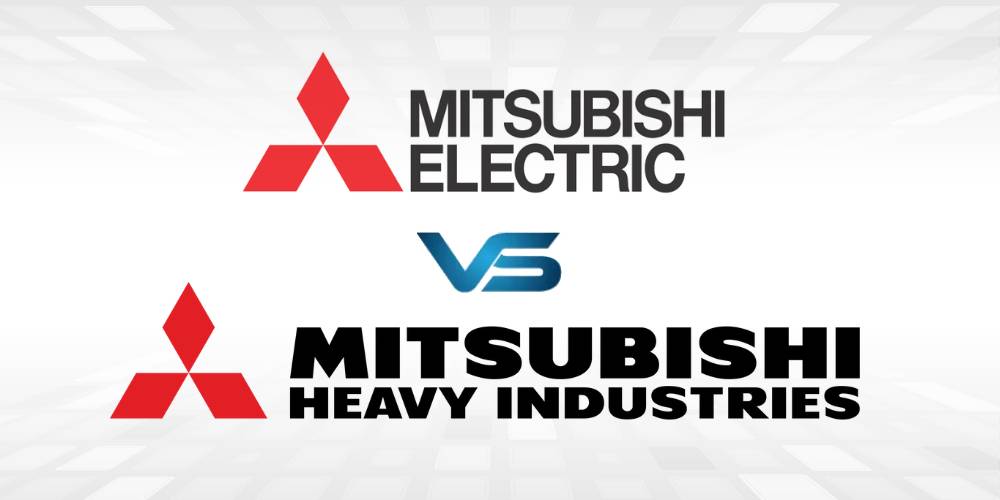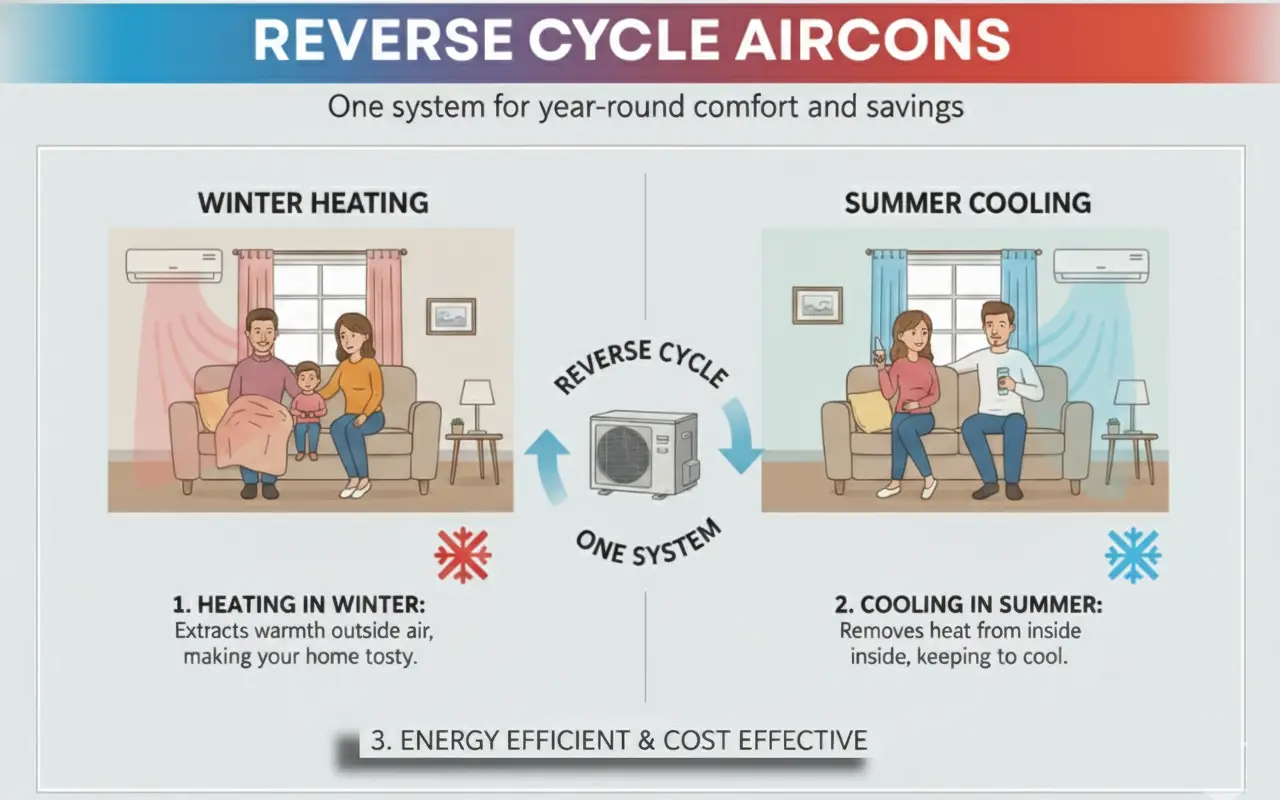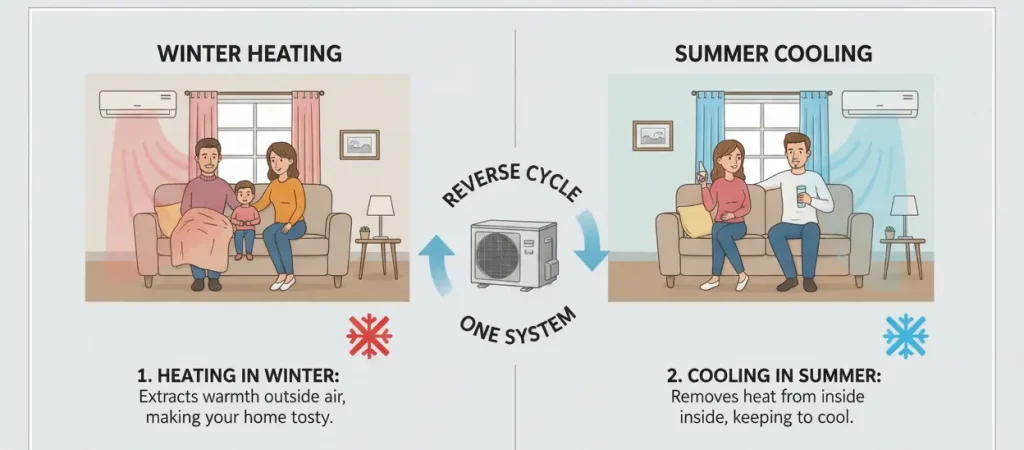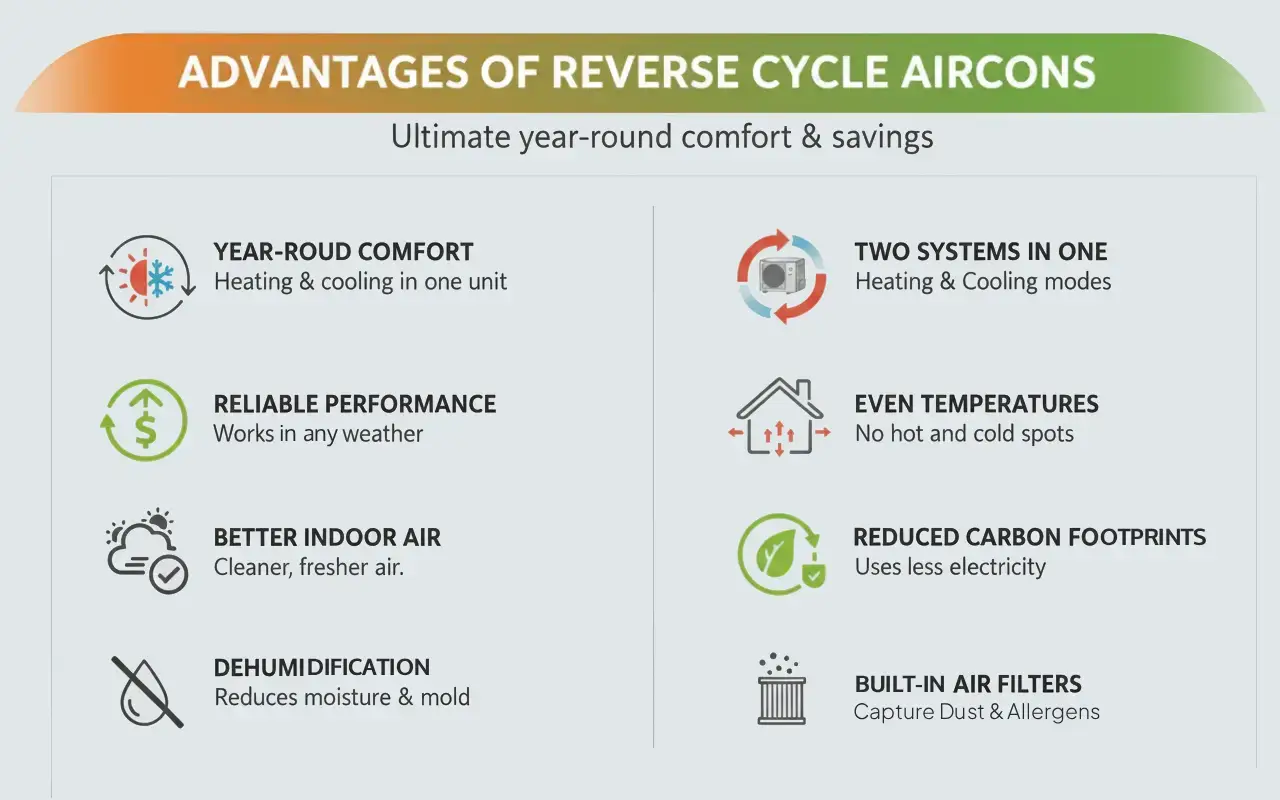
Same Name, Different Game: Which One Keeps Its Cool? 1. The Tale of Two Titans (Mitsubishi Electric vs Mitsubishi Heavy […]

It’s been said that you can’t manage the weather outside; however, you can manage the weather inside your home.
On a hot January afternoon, sitting in your living room in Sydney, you feel the heat wrap around your body like a thick woollen blanket, tightly wrapped around your body. Just six months earlier, that exact living room location on a crispy winter morning in Melbourne was surprisingly cold.
Now, imagine one sleek and whisper-quiet appliance can keep you cool in the heat and warm in the cold without effort (and without a hefty bill!).
That’s the magic of reverse cycle air conditioning.
Reverse cycle air conditioning is also called heat pump or ducted air conditioning.
This valuable and efficient system brings you both cool and warm air.
Unlike traditional air conditioning systems that only cool the air, reverse-cycle air conditioning reverses the refrigeration cycle to extract heat from the outside air and transfer it indoors during the colder months.
The basic principle behind the operation of reverse cycle air conditioners is a compressor unit with refrigerant to absorb heat from one area and release it in another. When in cooling mode, the system absorbs heat from the indoor air and releases it outdoors.
This results in a cooler and more comfortable environment.
On the other hand, when in heating mode, the process is reversed; the system absorbs heat from the outdoor air and releases it indoors, effectively warming up the space.
Also read: Your AC Running Cost Guide

Also known as a heat pump, reverse cycle air conditioning operates by extracting heat from the air and transferring it into your home or space to provide warmth.
Alternatively, it can be reversed to cool down your surroundings. The system comprises a unit, refrigerant lines, and a thermostat. In cooling mode, warm indoor air is passed over a cold evaporator coil that cools it down before releasing it into the room.
The extracted heat is then transferred to the unit, where it is released.
In heating mode, the system operates in reverse by extracting heat from the air and transferring it indoors. This clever design allows reverse cycle air conditioning to be an energy-efficient option for maintaining comfort throughout the year.
Now that we understand the basics of reverse cycle air conditioning, let’s delve into the technical processes behind its cooling and heating functions. In cooling mode, the warm indoor air is extracted and blown over a cold evaporator coil, which cools it down.
The heat from the air is then transferred to the outdoor unit, where it is released. In heating mode, the process is reversed. Heat is extracted from the outdoor air and moved indoors, providing warmth.
These processes rely on the efficient functioning of the compressor, condenser, and evaporator. Understanding these technical processes gives us a deeper appreciation for the remarkable functionality of reverse cycle air conditioning.
Reverse cycle air conditioning works using a compressor, condenser, and evaporator.
The compressor is like the system’s heart.
It moves the refrigerant around and heats it under high pressure. After that, this hot gas moves to the condenser. Here, it loses heat to the air outside, turning the refrigerant into a cool liquid.
Next comes the evaporator.
This is where the liquid refrigerant absorbs heat from the room.
It evaporates and cools the room down. All three parts coordinate their tasks to guarantee a comfortable temperature in your home or workspace.

The biggest advantage of a reverse cycle air conditioner is its ability to cool in summer and heat in winter. With just one system, you can stay comfortable all year long.
This two-in-one deal saves your space and eliminates the inconvenience of purchasing individual heaters and fans. You just set your desired temperature and leave the rest to the system, which will automatically switch between heat and cool modes as needed.
Example:
During summer, when the temperature reaches 30°C, the reverse-cycle system makes your house cool like an ordinary air conditioner.
During winter, when temperatures fall to 5°C, the same system reverses its operation to draw heat from the outside air (even in cold conditions) and heats your house with efficiency.
Reverse cycle systems are very energy efficient. They usually deliver more heating and cooling per kilowatt hour of electricity than many alternative options.
Fact: Certain models can provide up to 5kW of heat for each 1kW of electricity consumed, that’s 500% efficient!
This efficiency translates to cheaper energy bills and a reduced environmental impact. Reverse cycle systems are an environmentally friendly alternative compared to gas heaters or electric fan heaters.
1KW in, 5KW out reverse cycles heat smarter, cutting cost and energy waste.
Because they consume electricity (and not gas or wood) and are highly efficient, reverse-cycle air conditioners emit less greenhouse gas. This makes them an environmentally friendlier option, particularly when combined with solar power.
And many newer models utilise R32 refrigerant, which has a lower global warming potential than traditional refrigerants, so they are even more climate-friendly.
Traditional heating units, such as gas heaters or wood-burning stoves, have the potential to start fires or emit dangerous fumes inside.
Reverse cycle air conditioners, however:
One of the lesser-known advantages is the accurate temperature control they provide.
Today’s reverse cycle systems can keep your house at a constant indoor temperature without extreme swings. You can bid farewell to icy mornings and sweltering rooms. Whether it is +40°C outside or a cold winter night, your house will be perfectly comfortable.
Most new reverse cycle systems, particularly split and ducted ones, run quietly, making them ideal for:
Noise levels are generally below 30-40 decibels (roughly the same as a whisper), so they won’t interrupt your sleep or concentration.
Many systems now come with built-in air purification features, such as:
This is particularly helpful for people with asthma, allergies, or respiratory conditions.
Example:
Ali’s 5-year-old son has asthma. Since installing a reverse-cycle AC with HEPA filtration in their home, Ali noticed fewer asthma attacks and less coughing at night.
Though the upfront cost of a reverse cycle system can be more than a fan or portable heater, the long-term savings compensate. Owing to high efficiency and low operating costs, they typically pay themselves back in a few seasons.
Also, with proper maintenance, they can have a lifespan of 12–15 years or more, providing you with long-term peace of mind.
Modern systems feature smart technologies such as:
Preheat or precool your home on the way home, set the settings from your mobile phone, and even monitor your energy consumption in real time.
Unlike conventional gas heaters or ducted evaporative cooling, reverse cycle air conditioners demand very little maintenance.
Quick tasks such as :
It can keep your unit operating efficiently for years. And because they contain fewer moving parts than combustion systems, they’re less likely to undergo catastrophic breakdowns.
There are various kinds of reverse cycle units:
This variety makes it simple to select one that suits your budget, room size, and interior design style.
They also make a great, clean-cut alternative to clunky older models.
Unlike old-fashioned systems requiring several components and configurations, reverse cycle air conditioners put functionality and style in one efficient unit. For homeowners who want a minimalist, sophisticated interior, this is a huge advantage.
Regardless of whether you reside in a small apartment or a big house, reverse cycle systems can be custom-fit to suit you. Installation is generally fast and, in most instances, qualified for rebates in energy-saving programs.
Tip:
Look into local government initiatives, some of which provide discounts or cash back on the installation of energy-efficient heating and cooling systems. This makes the high-performance system more economical and desirable.
As reverse cycle air conditioners are prevalent and well-liked throughout the nation, you’ll have direct access to service professionals and replacement parts.
This way, you get speedier repairs, less waiting, and confidence that your system will continue running when you need it most.
Whether you’re in a tropical, temperate, or cold region, reverse cycle systems perform well across climate zones. Unlike evaporative coolers (which struggle in humidity) or gas heaters (which aren’t useful in summer), the reverse cycle offers a balanced solution in all conditions.
| Benefit | Why it matters in Australia |
|---|---|
| ✅ Heats and cools (one system) | In real homes, modern split systems use far less electricity for heating than portable/oil column heaters, noticeably lower winter bills. |
| ✅ High efficiency vs. resistive heaters | Often cheaper to run than gas heating. |
| ✅ Useful in humid coastal areas; reduces stickiness and mould risk better than fans or evaporative coolers. | With rising gas prices and improved AC efficiency, many households find reverse cycle is the better value for everyday heating. |
| ✅ Works well with rooftop solar | Daytime cooling (and shoulder-season heating) can be powered mainly by PV—standard across Australian homes. |
| ✅ Fast cooling + dehumidification | Wall splits for single rooms; multi-splits or ducted for whole-home comfort, depending on dwelling type. |
| ✅ Safer indoors | No combustion, fumes, or carbon monoxide risk compared with gas space heaters. |
| ✅ Flexible formats | Unlike evaporative coolers, which are important in drought-prone regions and water-restricted periods. |
| ✅ Quiet, steady comfort (inverter) | Inverter compressors ramp up/down to hold set-point and reduce on/off cycling noise. |
| ✅ Filtration options | Many units include basic filters that can help with pollen/dust; some add finer filters—handy during allergy seasons and smoke events. |
| ✅ No water use | Unlike evaporative coolers, important in drought-prone regions and water-restricted periods. |
| ✅ Climate-specific ratings available | Zoned energy labels help pick models suited to hot, average, or cold Aussie zones. |
| Drawback | Why it matters in Australia |
|---|---|
| ✅ Higher upfront cost | Draughty, uninsulated homes lose conditioned air fast—comfort and efficiency suffer until sealing/insulation is improved. |
| ✅ Performance drops in very cold snaps | Alpine areas/TAS can see reduced heating capacity; choose models rated for low ambient temperatures if you live there. |
| ✅ Modern refrigerants are lower-GWP than older ones but still potent if leaked; proper installation/servicing are important. | Requires clearances and a suitable location; strata/body-corp and neighbour noise rules may apply. |
| ✅ Modern refrigerants are lower-GWP than older ones but still potent if leaked; proper installation/servicing is important. | Needs a good building envelope |
| ✅ Running cost sensitivity to tariffs | Peak/TOU electricity rates can lift costs; savvy timer use and setpoints help. |
| ✅ Regular maintenance required | Filters need cleaning; coils and drains need periodic service to keep efficiency and air quality up. |
| ✅ Refrigerant environmental impact | Modern refrigerants are lower-GWP than older ones but still potent if leaked; proper install/servicing is important. |
| ✅ Air can feel dry/windy in heating mode | Some people notice dry air or drafts—good sizing, fan settings, and placement reduce this. |
| ✅ Duct losses (for ducted systems) | In hot roof spaces, poorly insulated/leaky ducts waste energy—specify quality ducting and installation. |
| ✅ Relies on electricity during outages | No heat/cool if the power goes out (unless you have storage/backup). |
How does a reverse-cycle air conditioner operate?
It works similarly to a heat pump, using a refrigeration cycle that is reversed, to satisfy whether you want to heat the atmosphere or cool it. In heating mode, it pulls warmth from the outdoor air (even in cold temperatures) and moves it inside. In cooling mode, it simply pulls heat from the inside and releases it outside.
What are the main components involved?
The system consists of a compressor, evaporator components and other coils, an expansion valve, a reversing valve (to change modes), and an air handler. These components are designed to work together to transfer heat efficiently.
What is the right size system I need for my space?
Sizing depends on the size of rooms or areas to be heated or cooled, the type and quality of insulation, and the climate zone. The output capacity is measured in kilowatts (kW). For accurate sizing, we recommend getting a professional load calculation performed.
How long does a reverse-cycle unit last?
If well-maintained, a portable air conditioner will last between 10 and 15 years, and a higher quality product may last longer.
Can a reverse cycle unit dry out the air?
That is a myth. The air conditioner in cooling mode may reduce the humidity in the air, but today’s units are designed to maintain a balance of moisture in the air. Many units even have a humidity control setting to stay comfortable.
What about maintenance? Do reverse cycle air conditioners need much maintenance?
For maintenance, you simply need to clean or replace the air filters and service them from time to time. At the time of professional installation, be sure the installer does a check-up to ensure energy efficiency, correct sizing, and longevity and use it regularly thereafter.